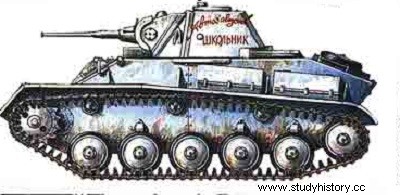
Type: light tank.
Crew: 2 men.
Armament: a 45mm L-46 cannon; a 7.62 mm DT machine gun.
Armour:
minimum 10mm;
maximum 60mm.
Dimensions:
length: 5 m;
width: 2.52m;
height 2.22 m.
Weight: 10t.
Ground pressure :0.67 kg/cm2.
Specific power: 14.5 bhp.
Engine: 2 ZIS-202 6 cyl. water-cooled gasoline engines, each developing 71 hp at 2,800 rpm.
Performance:
road speed: 51 km/h;
range 446 km;
vertical obstacle: 0.71 m;
clean cut 3.12m;
slope :34°.
Service time: in the Red Army from 1942 to 1948
The T-70 light tank began to replace the T-60 as early as the end of January 1942. Although it was realized that the light tank was not an effective vehicle, the fact that it was cheap and easy to be mass-produced allowed units to be equipped which otherwise would not have had a tank at all The enormous losses — estimated at more than 18,000 vehicles — suffered by the Soviet tank parks during the first six months of the war added to the delay in production due to the transfer of tank factories to the central regions of the USSR.
At that time, the major imperative was therefore to build tanks, whatever But as the war continued the production of medium and heavy tanks approached the desired level; the T-70 was therefore the last light tank put into service.
Built at the Gorky Automobile Workshops, it replaced the T-60 in light tank units. The T-70 had the same chassis as the T-60 (although the traction was transferred from the rear to the front), somewhat reinforced to meet the increase in weight, but it was armed with a cannon of 45 mm (with 70 shells) and a coaxial DT 7.62 mm machine gun (with 945 cartridges), mounted in a new wrought turret. The hull armor was also modified to provide a cleaner profile and better protection; the driver's hatch had an armored canopy. The driving force was doubled by the installation of two engines of the type used for the T-60.
In the middle of 1943 appeared the T-70A, an improved version, with reinforced armor and slightly more powerful engines. The turret, provided with a thicker armour, was flat at the rear and not curved like that of the T-70. In the fall of 1943, the production of medium tanks having increased, that of the light tanks T-70 and T-70A ceased. A total of 8,226 of these tanks had been built.
In 1944, the surviving chassis, provided with an additional wheel on each side, were converted into carriages for self-propelled guns. At the end of 1943, a further development of the T-70A gave birth to the light tank T-80 which, although it appeared identical to the previous one, had thicker armor. This vehicle, however, was never produced in large quantities.
